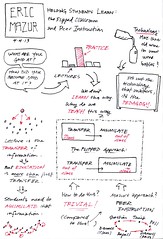In this series of articles, the Educational Technology team will be providing an insight into existing practice using technology for learning and teaching at Falmouth University and various projects being undertaken within the sector.
The flipped classroom is not a new method for learning, and actually refers to techniques that have been used for a while now. You may or may not realise that you’re using these techniques in your teaching. If you’re not, then the best reason for adopting a flipped approach to teaching and learning is that it offers pedagogical advantages. Within this post I am going to focus on a few different ways that learning can be flipped.
Knowledge transfer → knowledge assimilation, and just in time teaching
CC-BY-NC 2.0 licensed image by Derek Bruff
From the image you can see that Mazur proposes is that knowledge transfer should be covered prior to attending class, and that the class time be used to help students assimilate what they have read or watched prior to coming to class. The ‘flip’ is simply that knowledge transfer happens outside class, and knowledge assimilation happens in class.
Mazur puts emphasis on the assimilation of knowledge within the classroom through peer interactions. Content and readings that the students need to receive are disseminated prior to a class based session and students are expected to engage in that transfer of knowledge. Within the class he then poses questions and problems and polls students on their answers (so they commit to an opinion). Once that is done the students discuss between them and the ones that understand articulate it to the others. The questions and problems that are asked during the class time are usually based on results of quizzes that students are asked to complete before the lecture. This type of learning is referred to as ‘just in time’ teaching as the schedule and questions for the class session are often not determined until very close to its delivery.
Blending ‘just in time’ teaching and peer instruction are not the only approaches, and whilst there is no one correct way of doing things it’s probably safe to say that an approach which sees the students actively engaged in class, rather than passive, is likely to lead to them learning more. A visual idea of how the flipped classroom could work based on the above, is given below:
Farmer, 2015
This brings me onto Experiential Learning. This certainly isn’t a new idea, and was first talked about in the early 1900’s by John Dewey:
“The Teacher and the book are no longer the only instructors; the hands, the eyes, the ears, in fact the whole body, become sources of information, while teacher and textbook become respectively the starter and the tester. No book or map is a substitute for personal experience; they cannot take the place of the actual journey” (Dewey, 1915, p74).
Fast forward 100 years, and the same things are being discussed, just in a slightly different contexts. Technology is now part of the delivery of a flipped environment, using tools to engage the learner with materials and activities outside of the classroom, allow synchronous and asynchronous discourse, and acquire knowledge.
There is a lot of overlap in the phrases used for things like experiential, active and flipped learning. There are differences, but the general consensus is that getting students to access content and engage in activities designed to develop their understanding before class, and then using the class time to discuss and engage in depth brings issues, ideas and questions to the surface. The pre-class content and activities develops their knowledge and understanding more effectively when discussed and reflected on in class (Farmer, 2015).
Flipped learning offers the best of both online and face to face learning. In a similar vain to the message in the Lens on… Blended Learning post a while back, flipped learning should offer a seamless transition between the students’ own learning environment and the classroom. Each should compliment the other, with purpose and meaning being paramount. Students should be able to have the opportunity to experiment with ideas to learn through doing, in a supported environment where they learn from everything they do, apply their knowledge into problem solving, and assimilate their knowledge to develop it into concrete experience (Kolb, 1984).
Whilst researching for this blog post, what I didn’t find is much research about flipped learning in arts and creative subjects. There is a lot of information about the marked improvement of results and performance in science, technology, engineering and maths areas. It would be interesting to work up reasoning behind the lack of literature around flipped learning for creative subjects: is it because the nature of these disciplines is already experiential, and active? Engagement within a class environment is participative, and less didactic?
Educational Technology are very interested in learning more about how you engage your students inside and outside the classroom. Do you encourage a dynamic environment within your teaching spaces? How do you think it improves what you do and how your students learn?
Comment below or get in touch to tell us more 🙂
References:
Dewey, J., Dewey, E. (1915) Schools of To-morrow. New York: E.P. Dutton & Company.
Farmer, R., (2015) ‘What is the Flipped Classroom?’. LearnTech blog, [blog] 16 Jan 2015, Available at: http://blogs.northampton.ac.uk/learntech/2015/01/16/what-is-the-flipped-classroom/ Accessed [24 March 2016].
Kolb, D. A., (1984) Experiential learning: Experience as the source of learning and development. Englewood Cliffs, NJ: Prentice Hall.

